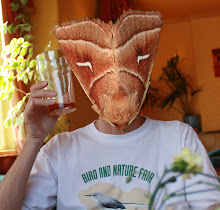We all trundled up to the family cottage on the shores of Portage Lake for the last couple of weeks of August. When not doing all the cottagy things that one does up there I found plenty of time to indulge in a bit of mothing. In the two weeks I notched up a nice list of mid-autumn specialties and a host of new micros.
Portage Lake is about 20 Km south of Parry Sound. We are lucky to be on the north edge of the lake which has excellent mixed woodland and shrubby-edged clearings all around. The moth list is ever-growing, especially since I'm slowly sorting through the micro bits. Below are a few of the nice moths to be found here at this time of year...

My highlight macro was this chunky noctuid called the White-tailed Diver. I've long wanted to see this moth and was totally surprised when it eventually did decide to reveal itself to me. The young larvae are leaf miners on aquatic plants such as cattails, water lilies and pickerelweed, after which they bore into the leaf stems. They then swin to shore and winter in lakeside leaf litter before pupating in the spring. Apparantly, second generation larvae (as was this individual) pupate in the larval tunnels. An amazing life history. This moth appears to be uncommon at best in Ontario so I have to thank the moth gods for this one...

The small but chunky Oligia minuscula. I've only ever seen this moth here, and not that often either. It seems to have a short flight period in mid August to early September. They usually have an obvious black bar in the median area of the forewing which this individual lacks.

A nice Dotted Sallow. This is generally the first of the orange sallows to emerge in the fall and, as you can see, is distinctly on the dotty side.

The lovely Scalloped Sallow in its usual "headstand" resting pose - don't ask me why! It is on the wing mostly in September. The larvae feed on a wide variety of trees and plants.

The complex-looking Sutyna privata. Again, I've only seen this moth here at Portage Lake and the surrounding area. Occasionally I've found it at rest in the daytime on Tamaracks in the middle of fens and bogs. Another September flier.

The oddly-named Old Man Dart. I like this one. It appears to be nothing special but a closer look reveals quite a nice subtle pattern on the forewing. The larva feed on a wide variety of trees and plants and the adult is on the wing in late August to early October.

The nice-looking Euxoa campestris. A typical "dart" this moth seems to be rather local, another Portage specialty as far as I'm concerned. I hadn't seen it for a while so I was happy to obtain a nice series of photos.

The sizeable Great Dart. Yet again, in Ontario I've only seen this moth here, but there again I do a lot of mothing here! I was very excited to catch some of these in UK last autumn where it is an irregular migrant in the southern half of the country. Over there it is called the Great Brocade, a name I prefer.

Finally, and though I did catch a great many neat micros, this was the pick of the bunch this time. Meet Archips alberta. This tortrix is quite large and beautifully patterned. I wasn't sure what it was at first but a quick glance through the MPG tortix pages steered me in the right direction. It seems to be rather local in Ontario.
So, a tiny fraction of the moths I caught during the two weeks. Well, gotta save a few pix for next time eh...


































